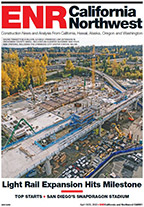Nonresidential building, at $137.7 billion (annual rate), increased 14% in April. The institutional side of the nonresidential market showed some improvement after a very weak March. Health-care facilities in April jumped 70%, aided by the start of four large projects: a $420-million medical center in La Jolla, Calif., a $300-million ambulatory care center in Philadelphia; a $234-million replacement hospital in Galveston, Texas; and a $114-million replacement hospital in Norfolk, Va.
The depressed public buildings category advanced 44% in April, helped by a $152-million police/fire station/community building in San Francisco and a $91-million courthouse complex in Norfolk, Va. Amusement-related construction rebounded 28% from its low March amount, and church construction increased 7%.
However, educational building (the largest nonresidential building category) slipped 3%, with its April amount coming in 23% below its average monthly pace during 2011. The further erosion for the educational building category came despite the April start of a $136-million high school in San Marcos, Calif., and a $132-million museum in Miami.
The commercial side of the nonresidential market featured a sharp 45% increase for store construction in April, reflecting the start of a $400-million renovation of Macy’s flagship department store in New York City. Office construction retreated 4%, although April did include groundbreaking for such projects as an $80-million office building in Washington, D.C., and a $50-million historic restoration of an office building in San Francisco.
Warehouse construction in April dropped 13%, while hotel construction fell 36% from its elevated March pace. Even with its decline, hotel construction in April included the start of a $120-million hotel complex in Los Angeles. The manufacturing plant category in April climbed back 136% from an extremely depressed March, helped by projects such as a $255-million chemical plant in Westlake, La., and an $85-million automotive stamping plant in Arlington. Texas.
Residential Building
Residential building in April grew 1% to $148.0 billion (annual rate). Single-family housing continued to edge upward, rising 2%, and revised statistics show that it has now registered modest improvement in 10 of the past 12 months. The amount of single-family housing in April was up 21% relative to its average monthly pace for 2011.
Multifamily housing in April settled back 1% after its 6% gain in the previous month. Large multifamily projects that reached groundbreaking in April included a $100-million addition to an apartment building in New York City, an $89-million apartment building in Brooklyn, N.Y., and a $75-million conversion of a hotel into a condominium building in New York City. The amount of multifamily housing in April was up 9% relative to its average monthly pace for 2011.
The 4% gain for total construction starts on an unadjusted basis during the first four months of 2012 came as the result of large increases for two of its three major sectors. Non-building construction was up 25% year-to-date, as a 103% surge for electric utilities far outweighed a 9% decline for public works. Residential building year-to-date advanced 18%, with single-family housing climbing 21% while multifamily housing rose 7%. Nonresidential building was the one major sector to report a year-to-date decline, sliding 25%, with decreased activity for these segments—commercial building, down 14%; institutional building, down 26%; and manufacturing plants, down 60%.
The year-to-date decline for nonresidential building reflects in part the comparison to the briefly elevated amount during the first four months of 2011, which included large projects such as the $1.2-billion redevelopment of the Delta Terminal at New York’s JFK International Airport, the $1.1-billion National Security Agency data center in Utah, a $900-million semiconductor plant in Oregon, and the $580-million Transbay Transit Center in San Francisco.
By geography, total construction during the first four months of 2012 showed a large gain in the South Atlantic, up 77%, boosted by the work at the nuclear power facilities in Georgia and South Carolina. The Midwest was unchanged year-to-date, while declines were reported in the Northeast, down 14%; the West, down 15%; and the South Central, down 20%.
Useful perspective comes from looking at 12-month moving totals, in this case the 12 months ending April 2012 versus the 12 months ending April 2011. On this basis, total construction is up 1%, with this behavior for the major sectors: non-building construction up 5%; residential building up 13%; and nonresidential building down 11%.
By geography, the 12 months ending April 2012 showed the following performance for total construction compared to the prior 12 months: the South Atlantic, up 39%; the West, unchanged; the Midwest, down 6%; the South Central, down 11%; and the Northeast, down 12%.


Post a comment to this article
Report Abusive Comment